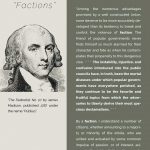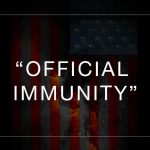Last Updated on October 5, 2021 by Constitutional Militia
The penchant of all too many Americans for indulging in socially destructive rationalizations and delusions seems limitless. No sooner had the Internet come alive with warnings about the implications—if not the specific intent and inevitable consequences— of National Security Presidential Directive 51 (including my own commentary, “The Kakistocracy Exposes Its Hand”), than the naive bloggers and malign agents of influence in the electronic Peanut Gallery began yawning, “So what?” As they tell it, NSPD-51 is not really anything new—other Administrations have floated various “continuity-of-government” plans. NSPD-51 itself promises that the President will act in accordance with constitutional standards. And, after all, what else can be done during what NSPD-51 calls a “[c]atastrophic emergency,” except to turn over control of the General Government—and, by extension, of American society as a whole—to a centralized, unitary leadership?
Wrong, wrong again, and completely wrong.
I. True enough, former Administrations have devised “continuity” plans. But those plans arose out of, reflected, and would have operated in a political context radically different from what prevails today. Now, Americans are witnessing a political vortex accelerating before their very eyes: an intensifying consolidation of power in the General Government, an increasing concentration of that power in the Executive Branch, and an expanding militarization of that Branch. These developments manifest themselves not only in hyperbolic, if not utterly hysterical, official propaganda and agitation saturated with references to an endless global “war” with “Islamo-fascism,” but also in actual field operations in which common criminals (so-called “terrorists”) are verbally transmogrified into “enemy combatants,” so that they can be denied elementary due process of law, held incommunicado indefinitely, tortured, and tried before military juntas—setting perverse precedents for applying such treatment to common Americans who run afoul of the regime. Worse yet, this agitprop overflows with appeals to an imagined set of “inherent powers” of the President, and to his supposedly limitless authority as “Commander in Chief” in time of “war.”
The latter legalistic rationalizations amount only to nonsense thrice compounded. First, under the Constitution, no Branch of the General Government enjoys any “inherent powers,” but only such powers as the Constitution delegates. And far from any facile assumption that any power is “inherent,” “[t]he burden of establishing a delegation of power * * * is upon those making the claim.” Bute v. Illinois, 333 U.S. 640, 653 (1948). Second, the President is not “Commander in Chief” of the country as a whole, in the manner of some jack-booted Führer or opera buffa Ducé. Instead, he is “Commander in Chief” only “of the Army and Navy of the United States, and of the Militia of the several States, when called into the actual Service of the United States.” Article II, Section 2, Clause 1. Moreover, even in that limited capacity, he is subject to the supervening control of Congress, to which the Constitution delegates the powers “[t]o make Rules for the Government and Regulation of the land and naval forces,” and “[t]o provide * * * for governing such Part of the[ Militia] as may be employed in the Service of the United States.” Article I, Section 8, Clauses 14 and 16. Third, “war” in no way adds to the President’s powers. Besides enjoying complete authority to provide for governing the Army and Navy at all times and “the Militia of the several States” when “employed in the Service of the United States,” Congress alone has the power “[t]o declare War”—and by necessary implication, to declare that a “War” being prosecuted must cease, as well as to determine what is “necessary and proper” in the conduct of any “War.” Article I, Section 8, Clauses 11 and 18. And should the President refuse to accede to Congress’s commands, Congress may remove him from office—including the office of “Commander in Chief”—through impeachment and conviction. Article I, Section 2, Clause 5; Article I, Section 3, Clauses 6 and 7; and Article II, Section 4.
Of course, the friends of das Fuhrerprinzip (the Leader Principle) are wont to fall back on the notion that because, in a “[c]atastrophic emergency,” the President can supposedly declare “martial law” or suspend the writ of habeas corpus anyway, therefore in even the most latitudinarian interpretation NSPD-51 amounts to no great accretion to his powers. The situation is not as simple as these simpletons assume, however.
The Constitution does not provide an explicit power for any Branch of the General Government to declare, recognize, or enforce “martial law.” Indeed, the Constitution does not even use, let alone define, the term “martial law.” No doubt, this studied absence reflects the Founding Fathers’ familiarity and agreement with the warning of their legal mentor, Sir William Blackstone, that the strictures of “martial law”
are to be looked upon only as temporary excrescences bred out of the distemper of the state, and not as any part of the permanent and perpetual laws of the kingdom. For martial law, which is built upon no settled principles, but is entirely arbitrary in it’s decisions, is * * * in truth and reality no law, but something indulged, rather than allowed as a law: the necessity for order and discipline in an army is the only thing which can give it countenance; and therefore it ought not to be permitted in time of peace, when the * * * courts are open for all persons to receive justice according to the laws of the land.
Commentaries on the Laws of England (Philadelphia, Pennsylvania: Robert Bell, American Edition, 1771- 1773), Volume 1, at 412.
Furthermore, and most revealingly, when the Constitution does identify which “martial” institutions are to exercise the power and duty “to execute the Laws of the Union, suppress Insurrections, and repel Invasions,” it explicitly empowers Congress “[t]o provide for calling forth the Militia,” and “the Militia” only, for those purposes. Article I, Section 8, Clause 15. Nowhere does the Constitution assign those tasks in the first instance to “the Army and Navy of the United States”—a lacuna that could not possibly have been accidental. So, because the Constitution requires the President to “take Care that the Laws be faithfully executed” (Article II, Section 3), and provides for “calling forth the Militia to execute the Laws of the Union” (as well as to “suppress Insurrections” and “repel Invasions”), and designates the President as “Commander in Chief * * * of the Militia, when called into the actual Service of the United States,” the conclusions are inescapable that: (i) “the Militia of the several States” are to constitute the first line of defense in any “[c]atastrophic emergency;” (ii) Congress, not the President, is to define the circumstances under which the Militia are to be “call[ed] forth;” and (iii) only if the Militia prove insufficient to the task are “the Army and Navy of the United States” to be employed (again, pursuant to ultimate Congressional, not Presidential, governance and regulation). Given that “martial law” is (in Blackstone’s trenchant phrase) “in truth and reality no law” at all; and given that “calling forth the Militia” is an explicit part and parcel of the supreme law of the land; and given that “the Militia of the several States,” properly regulated, are to consist of all able-bodied Americans from 16 to 60 years of age—then “calling forth the Militia” would differ radically from what most people imagine that declaring “martial law” would entail.
A power to suspend the writ of habeas corpus would not amount to full-blown “martial law,” either. To be sure, as Blackstone taught the Founders,
confinement of the person, by secretly hurrying him to goal, where his sufferings are unknown or forgotten, is * * * a * * * dangerous engine of arbitrary government. And yet sometimes, when the state is in real danger, even this may be a necessary measure. But the happiness of [the English] constitution is, that it is not left to the executive power to determine when the danger of the state is so great, as to render this measure expedient. For the parliament only, or legislative power, whenever it sees proper, can authorize the crown, by suspending the habeas corpus act for a short and limited time, to imprison suspected persons without giving any reason for so doing.
Commentaries, Volume 1, at 136.
Following Blackstone, the Constitution explicitly requires that “[t]he Privilege of the Writ of Habeas Corpus shall not be suspended, unless when in Cases of Rebellion or Invasion the public Safety may require it.” Article I, Section 9, Clause 2. Moreover, this provision not only recognizes “[t]he Privilege of the Writ of Habeas Corpus” as pre-existing and therefore independent of the Constitution—by implication, locating it among the Declaration of Independence’s “certain inalienable Rights, * * * among [which] are * * * Liberty”—but also defines and narrowly limits the circumstances under which the writ may be “suspended.” Not just any conditions of “Rebellion or Invasion” will suffice, but only those perforce of which “the public Safety may require it.”
As Blackstone wrote with respect to the English constitution, so too “the happiness of” America’s Constitution “is, that [suspension of the writ] is not left to the executive power to determine.” Because the Constitution does not include the authority to suspend the writ of habeas corpus as an enumerated power of the Executive Branch, the President cannot unilaterally assume that authority through some “directive” such as NSPD-51, whether in the course of what he claims is a “[c]atastrophic emergency” or otherwise. Rather, because that authority appears in Article I, the part of the Constitution that sets out the powers, disabilities, and duties of the Legislative Branch, only Congress can determine, through a statute, when it may be “necessary and proper” to empower the President to take such action. See Article I, Section 8, Clause 18.
But, if and when Congress grants such authority, it must also define and limit it, in keeping with constitutional requirements. Congress must designate what constitutes “Cases of Rebellion or Invasion,” as those concepts were understood in the late 1700s. And Congress must provide for, or at a minimum allow, judicial review so that persons wrongfully confined may still seek a writ of habeas corpus, requiring the President to prove that any “suspen[sion]” thereof supposedly applicable to them actually arose in the context of a true “Case[ ] of Rebellion or Invasion,” and that “the public Safety * ** require[d] it.” And if Congress does not provide or allow, or affirmatively attempts to preclude, judicial review, then the Judiciary must intercede, because “[t]he Privilege of the Writ of Habeas Corpus” is antecedent to the Constitution, and can be temporarily “suspended” only in accordance with constitutional standards.
Obviously, circumscribed by these constitutional strictures, suspension of “[t]he Privilege of the Writ of Habeas Corpus” by itself could never constitute or entail “martial law.”
Morever, even if the courts were not open because of a “Rebellion or Invasion”, the Militia could be employed for enforcing the suspension—for “suppress[ing] Insurrection[s]” and “repelling Invasion[s]” are among the duties for which the Militia may be “call[ed] forth”. And, if the courts were open, suspension of “[t]he Privilege of the Writ of Habeas Corpus” might be enforced even without employing the Militia, let alone the Army or Navy.
So much for the notion that NSPD-51 can be disregarded or excused on the grounds that a constitutional Presidential dictatorship is already possible under color of a declaration of “martial law” or a suspension of the writ of habeas corpus.
Unfortunately, Americans who do not know even in what century the Civil War was fought (as to which millions of high-school and college students are ignorant) may have a difficult time parsing the Constitution on these particulars. Ominously, too, instead of exposing the errors behind, and denouncing the implications of, the present rush towards Executive Branch “Decidership,” influential voices in the self-styled “conservative” media seem interested more in apologizing for, if not praising and promoting, these developments, than in recommending and explaining the constitutionally correct contrary course of action. So, widespread public ignorance and intellectual apathy, exacerbated by torrents of official propaganda and the chorus of approval from the present Administration’s toad- eaters in the media, make this arguably the most politically perilous period in American history.
II. NSPD-51 is not simply a continuation of this downward spiral of political events into History’s toilet, but instead exacerbates the situation significantly. And this, precisely because NSPD-51 is not in keeping with constitutional standards or safeguards.
NSPD-51 tells America that, from now on, “[e]nduring constitutional government * * * means a cooperative effort among the executive, legislative, and judicial branches of the Federal Government, coordinated by the President, as a matter of comity with respect to the legislative and judicial branches and with proper respect for the constitutional separation of powers among the branches, to preserve the constitutional framework under which the Nation is governed and the capability of all three branches of government to execute constitutional responsibilities and provide for orderly succession, appropriate transition of leadership, and interoperability of the National Essential Functions during a catastrophic emergency” (paragraph 2(e)). For part 2 click below.




































